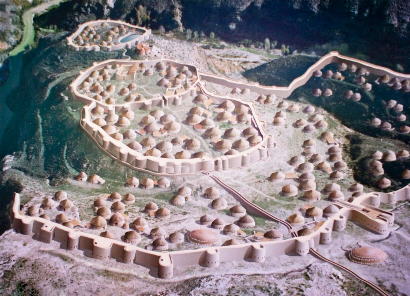++++++++++++++++++++++++++++++++++++
IBERIA / SOUTHERN GAUL
++++++++++++++++++++++++++++++++++++

fortified Settlement of Los Millares in Granada
| LORDS OF the EARTH 38 - the DAWN OF CIVILIZATION | |
| Newsfax Turn: #15 ( 2060 - 2056 BC ) | |
| September 12, 2017 |
|
MEDITERRANEAN MAYHEM
2060 BC In Ses Paisses the Tartessian leader Jose was ashore conducting negotiations. Seven Tartessian light trade galleys were anchored in the harbor with crews mostly off duty. In late spring a Nuragic squadron of five pentaconters was approached the harbor accelerating to ramming speed. The surprised Tartessian sailors made haste to get underway but most their galleys had barely cleared the docks when two were rammed and left sinking while three others were scraped their length by bronze rams which sheared off the oars. The captains of the stricken boats surrendered to avoid more bloodshed. Two Tartessian ships managed to escape towards the west. Four Nuragic trade galleys then docked and the transported soldiers debarked and secured the port. A pentaconter which had taken damage1 backing out its ram docked next and repairs begun. Pasquale ordered the elders of Ses Paisses who'd changed their loyalty from Nuragic to Tartessos seized and beheaded. 2059 BC Pasquale was meeting with new elders in late spring when a Minoan fleet of six pentaconters and five Bull class biremes approached the harbor. the anchored Nuragic ships had been kept in readiness but the crews thanked their gods when the newcomers slowed to safely anchor. Nine Minoan trade galleys and two light galleys then docked and almost two thousand Etruscan infantry debarked and secured the port. Minoan diplomat Arkalokri told Pasquale the Nuragic force could leave unharmed but would not be allowed to stay. A seething Pasquale ordered his troops to board ship and the Nuragic force departed towards the east. Arkalokri began meeting with the village elders. Late in the year Minoan vassal Ploion Krafikos of Miletos arrived off Tunis aboard his pentaconter with orders to follow any warships or troop transports leaving the port. 2058 BC Back in the Baelerics by early in the new year Arkalokri had overcome language and religious differences and convinced the Ses Paisses elders to pay such tribute to both Minoans and Etruscans - at least whatever the impoverished fishing village could manage. Considering how often the location had changed hands, the Etruscans posted a garrison and the Minoans left behind laborers and equipment for future fortification. Also early in the new year Ploion's crew missed scouting2 a Heraklopolitan squadron of pentaconters exiting Tunis during a rain squall. They however soon noticed his ship and doubled back. Their commander Ramses IV had orders to react to any intrusion in the Bay of Tunis. Ploion's galley was rammed and sunk as witnessed by a passing merchant galley from Kytheria. Back in the Baelerics in late April the remaining Etruscans boarded the Minoan transports (along with a few score half-starved Tartessian POWs) and the fleet departed Ses Paisses heading southeast into the Bay of Tunis past the coast of Herakleopolis. They were scouted and intercepted between Sardinia and Cap Serrat by seven pentaconters commanded by Ramses IV. The Minoan warships turned to shield the trade galleys and both forces closed at speed. The Egyptians rammed and sank one Minoan pentaconter while damaging another as well as a bireme. However the better trained Minoans sank two Herakleopolitan pentaconters and inflicted damage upon four others. Ramses IV was badly shaken and signalled retreat toward Tunis. Fteriku - who needed to protect the transports - signalled his ships to resume course for the Etruscan port of Luni. Once the Etruscans disembarked the Minoan trade galleys left with Arkalokri while Fteriku headed back to the Gulf of Tunis with five pentaconters and five biremes - one of each at reduced capabilities due to damage. 2057 BC The Herakleopolitan squadron had returned to the Bay of Tunis - earlier damage having been repaired3 over the winter - and spotted the Minoan fleet. Ramses IV knew how another open-sea engagement would likely go and so ordered a return to Tunis. The Minoan fleet was likewise aware of the Egyptians and followed. Knowing from intel received in Luni that Tunis lacked walls (and therefore harbor defenses) Fteriku left his damaged galleys to keep watch and ordered his eight undamaged ships into the port hoping to finish off the Herakleoplitan navy. Ramses IV stationed his five pentaconters to engage the Minoans in the narrow harbor mouth. The tactic worked at first, one Minoan war galley being holed while another and a bireme were each oar-sheared by rams that raked along one side. However the better trained sailors of Crete sank one Egyptian ship and damaged three others. A dismayed city population watched as in turn each of their boats were trapped and rammed. Many crew drowned but some reached shore including Ramses IV who emerged from the filthy harbor water vowing revenge. While anchored in the outer harbor the damaged galleys were patched enough to survive open seas. Fteriku did not wish to be in the harbor at nightfall and so signalled the fleet to head out. For the rest of the year and much of the next traders reported being stopped by Minoan ships, boarded and then allowed to continue once it was evident they were carrying cargo rather than soldiers. . |
1 in L38 nonwarships have a defensive combat value to calculate the results of
damage one side inflicts upon the other. It is therefore possible for a warship to take damage
(structural) when ramming or oar-shearing a nonwarship. Stuff happens.
2 in L38 to determine if one ship(fleet) sees the other the commander makes a combat check (roll d10 vs combat stat) with modifiers such as the other ship(fleet) attempting to Evade.
3 in L38 damaged ships that are in a controlled port of at least settlement-sized
are assumed to be repaired over winter (cost assumed included in Support).